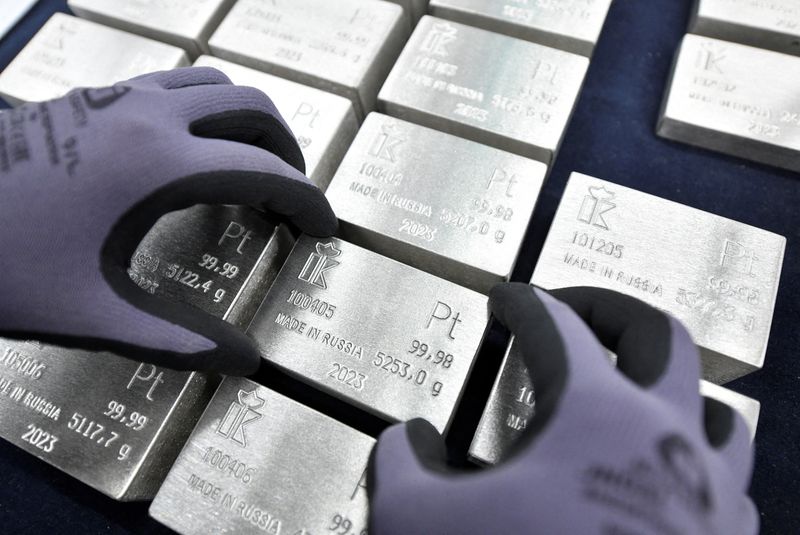By Polina Devitt and Ashitha Shivaprasad
LONDON (Reuters) - In the usual way of things, platinum and palladium should be turning higher after a slide from recent peaks drove supply deficits, job cuts and looming mine closures in top producer South Africa. That they're not shows how hard the electric car revolution has hit demand forecasts.
Along with close relative rhodium, the two metals are chiefly used in the catalytic converters used to clean exhaust fumes by the auto sector, an area that accounts for some 40% of platinum demand, and 80% of palladium offtake.
Losing that demand will be significant for all three metals - and for palladium and rhodium, there is currently no other industry that can realistically replace the volumes that will be lost as consumers transition to electric vehicles, which don't need autocatalysts.
Analysts see a long tail for PGMs use in traditional internal combustion engines, and a drop in supply as mining becomes less economic has kept prices relatively well supported. But with fellow precious metal gold at all-time highs this year, that's a disappointing performance.
"The PGM sector is facing a shift in which palladium and rhodium will see declining demand with no major alternative demand sector on the forecast horizon," Wilma Swarts, head of PGMs at consultancy Metals Focus, told Reuters.
Estimates of when the erosion of PGM demand from auto makers will become significant vary, and depend on views of future sales of pure internal combustion vehicles versus hybrid or electric vehicles.
According to analysts at Macquarie, demand for both platinum and palladium from the auto sector will start falling beyond 2025.
Earlier this decade palladium was a standout performer among precious metals, more than tripling in price between late 2018 and early 2022 to more than $3,000 an ounce. At just over $1,000 an ounce, it has now given up the price premium it had held to platinum since 2018.
Both palladium, down 9% so far this year after a 39% slump in 2023, and rhodium, a small, illiquid market which has clawed back a little ground this year after dropping almost two-thirds in 2023, have further to slide, according to analysts whose estimates cover the next five years.
But platinum, down 9% so far in 2024 after sliding 8% in 2023, may fare better. It is the only major metal in the group that is expected to rise by 2028 from last year's level, helped by demand in non-auto industries such as jewellery.
Producers and analysts also hope the metal has potential to benefit from new demand from the hydrogen economy via fuel cell vehicles, a slower-growing competitor to battery electric technology in cars.
But hopes for an acceleration of demand from fuel cell vehicles appear to be built on shaky ground.
"The current pace of deployment of fuel cell vehicles is certainly disappointing," said one person at a company involved with the technology.
In Macquarie's base case scenario, total annual hydrogen-related demand will struggle to rise materially above 250,000 ounces of platinum by 2030. For comparison, the auto sector currently consumes 3.3 million ounces of platinum a year.
Analysts are more certain that the supply side will support platinum in the future through declining output from mines.
The World Platinum Investment Council, whose members are major Western producers, expects platinum to be in an average annual deficit of 500,000 ounces until 2028. Shortages will cut above-ground stocks to six weeks of demand by end-2028 from 23 weeks at end-2023.
Macquarie's five-year outlook, which sees average 2028 palladium prices falling by 40% from 2023 levels to $800 per ounce, conversely expects platinum prices to rise to $1,250 an ounce by 2028, up 29% from 2023.
For South Africa's platinum miners, that is cold comfort. According to consultancy Metals Focus, South African PGM miners currently get just 35% of their revenue from platinum.

Even at current prices, around half of South African mines are producing their PGMs at a loss, prompting them to rely on other products such as chrome. Mines in North America are under pressure too, according to Metals Focus.
"Palladium was over-valued compared to platinum in recent years," said a major PGMs producer. "That was certainly very pleasant, but it's over."